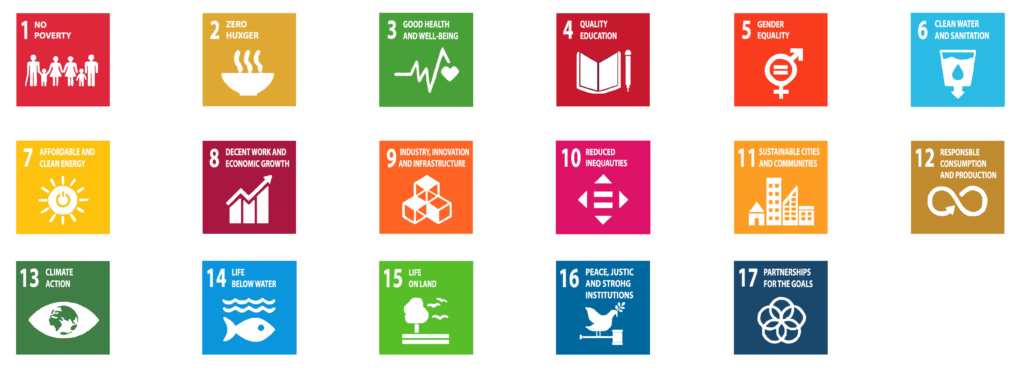The Sustainable Development Goals (SDGs) are a set of 17 global goals adopted by the United Nations in 2015 as part of the 2030 Agenda for Sustainable Development. The SDGs aim to address various social, economic, and environmental challenges facing the world and provide a framework for sustainable development efforts.
Here is a brief overview of the 17 SDGs:
- No Poverty: End poverty in all its forms and dimensions.
- Zero Hunger: Achieve food security, improve nutrition, and promote sustainable agriculture.
- Good Health and Well-being: Ensure healthy lives and promote well-being for all at all ages.
- Quality Education: Ensure inclusive and equitable quality education and promote lifelong learning opportunities.
- Gender Equality: Achieve gender equality and empower all women and girls.
- Clean Water and Sanitation: Ensure availability and sustainable management of water and sanitation for all.
- Affordable and Clean Energy: Ensure access to affordable, reliable, sustainable, and modern energy for all.
- Decent Work and Economic Growth: Promote sustained, inclusive, and sustainable economic growth, full and productive employment, and decent work for all.
- Industry, Innovation, and Infrastructure: Build resilient infrastructure, promote inclusive and sustainable industrialization, and foster innovation.
- Reduced Inequalities: Reduce inequality within and among countries.
- Sustainable Cities and Communities: Make cities and human settlements inclusive, safe, resilient, and sustainable.
- Responsible Consumption and Production: Ensure sustainable consumption and production patterns.
- Climate Action: Take urgent action to combat climate change and its impacts.
- Life Below Water: Conserve and sustainably use the oceans, seas, and marine resources for sustainable development.
- Life on Land: Protect, restore, and promote sustainable use of terrestrial ecosystems, sustainably manage forests, combat desertification, halt and reverse land degradation, and halt biodiversity loss.
- Peace, Justice, and Strong Institutions: Promote peaceful and inclusive societies, provide access to justice for all, and build effective, accountable, and inclusive institutions at all levels.
- Partnerships for the Goals: Strengthen the means of implementation and revitalize the global partnership for sustainable development.
These goals are interconnected and aim to address the most pressing global challenges, including poverty, inequality, climate change, environmental degradation, and promoting peace and justice. Achieving the SDGs requires collaboration and action from governments, businesses, civil society, and individuals worldwide. - https://sdgs.un.org/
Here’s some additional information about the Sustainable Development Goals (SDGs):
- The SDGs were adopted by all United Nations member states in 2015 as part of the 2030 Agenda for Sustainable Development. They build upon the Millennium Development Goals (MDGs), which were a set of eight goals established in 2000 to address poverty, education, health, and other global challenges.
- The SDGs are universal, meaning they apply to all countries, regardless of their level of development. They recognize that sustainable development requires action from all countries, both developed and developing, and that global challenges can only be effectively addressed through collective efforts.
- The SDGs are integrated and indivisible, emphasizing the interconnectedness of various social, economic, and environmental issues. They recognize that progress in one goal often relies on progress in others. For example, ending poverty (Goal 1) requires access to quality education (Goal 4), good health and well-being (Goal 3), and decent work and economic growth (Goal 8).
- The SDGs provide a comprehensive framework for sustainable development, encompassing a wide range of issues. In addition to the goals mentioned earlier, they also address topics such as clean water and sanitation, affordable and clean energy, sustainable cities, responsible consumption and production, and biodiversity conservation, among others.
- Achieving the SDGs requires the involvement of multiple stakeholders, including governments, businesses, civil society organizations, academia, and individuals. Collaboration between these stakeholders is crucial for implementing effective policies, programs, and initiatives to advance the goals.
- Monitoring progress towards the SDGs is essential to ensure accountability and drive action. Indicators have been developed for each goal to track progress at the global, regional, and national levels. Regular reporting and analysis help identify areas where more effort is needed and highlight successful strategies and practices.
- The SDGs also emphasize the importance of financing for sustainable development. While governments play a significant role in mobilizing resources, it is recognized that additional financial flows, such as foreign direct investment, private sector investments, and innovative financing mechanisms, are required to achieve the goals.
- In order to implement the SDGs effectively, countries have been encouraged to develop their own national strategies and action plans aligned with the global goals. This allows each country to tailor the goals and targets to their specific context and priorities while working towards the overall vision of sustainable development.
The SDGs represent a shared vision for a sustainable and inclusive future. They provide a roadmap for addressing the world’s most pressing challenges and creating a more equitable and resilient world for present and future generations.

